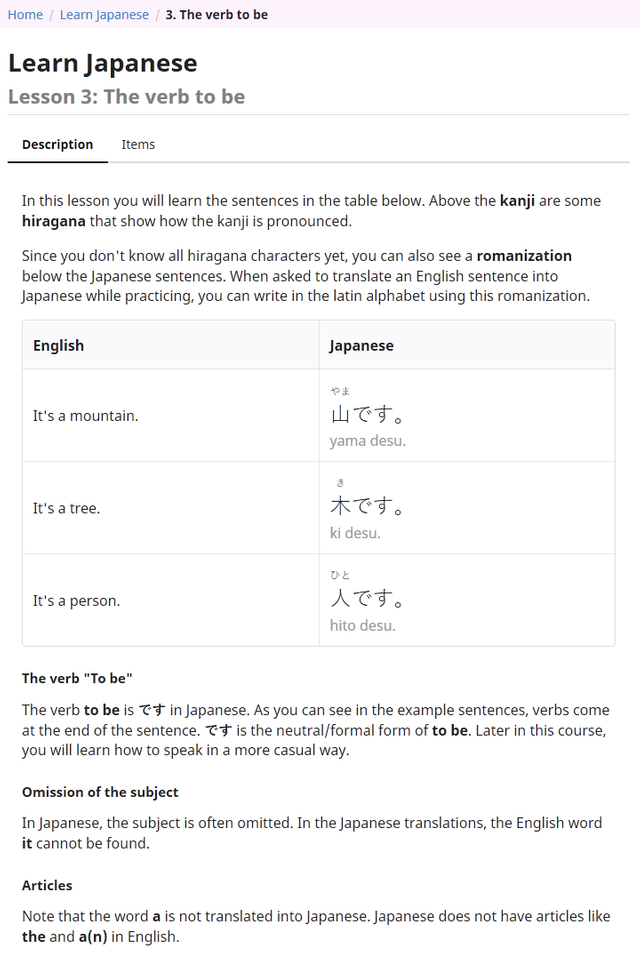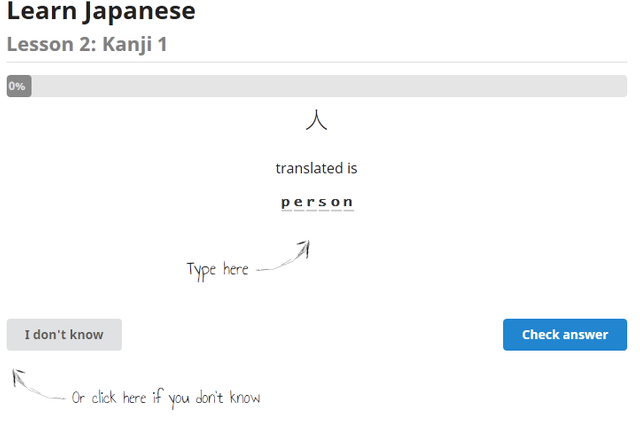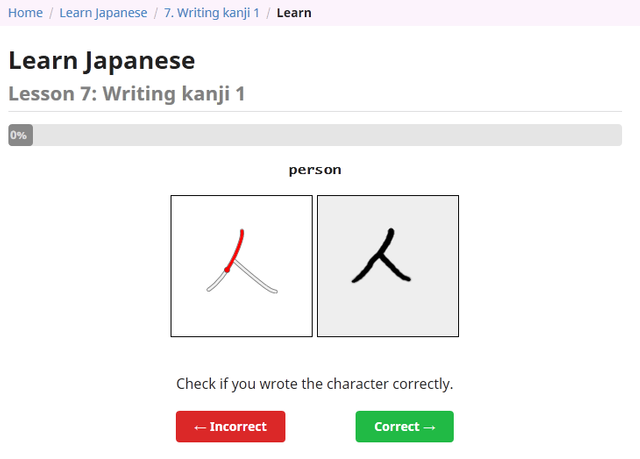A review of elon.io, a cool and free website for learning Japanese basics
In this first installment of reviews of cool software/apps for learning languages, and more specifically Japanese, I would like to share a short review of https://elio.io.
It is a bit obscure, at least compared to more recognizable brands, such as Duolingo or Memrise, but still an interesting find considering it is completely free, (minor spoiler ahead) well designed and covering a lot of basics.
I've put up a summary at the end if you're in a TL;DR rush.
What is elion.io?
Borrowing their own words:
Other platforms mostly teach you words and sentences, and only slightly touch the subject of grammar. At Elon.io, we aim to give you a thorough understanding of every piece of grammar the moment you start using it. In that way, you'll master the language much better in the long run.
elon.io is composed of 149 lessons encompassing basically everything, except speaking: radicals, Hiragana, Katakana, Kanji, vocabulary, grammar and writing.
I've been using it the past few weeks, tried it on my PC and then I've been using it exclusively on my phone.
I cannot alas remember at all how I stumbled onto this website, but I was pleasantly surprised by what I found:
As you can see, in addition to Japanese, you can learn Spanish, Turkish and... Biology? Seems like there is a black sheep in there, but hey, why not?
How does it work?
Elon.io uses spaced repetition based on interference, and as mentioned on the main page:
This means that instead of repeating a word after a certain amount of time, we repeat it after a certain amount of interference (from other words). We belief this to be a much better reflection of how our memory actually works, and therefore more effective.
I've not yet encountered this particular form of spaced repetition, or at least, if I did, I was unaware of it. If you've never heard of SR, it consists in periodically refreshing your memory of things you've learned, with time varying between reviews depending on success/failures at remembering them.
In addition to SR, the learning process is composed of 149 lessons, and each lesson falls into one of the following categories:
- Learning new Hiragana, Katakana and Kanji
- Writing Hiragana, Katakana or Kanji
- Grammar points
- Reading exercises
After each lesson, you are presented with a review composed of multiple questions. You can be wrong during the reviews, which will only make the website ask the question again. And the lesson/review is considered done when you've achieved 100% of right answers (disregarding those that were previously answered wrong)
Lessons
Lessons are always related to one subject, whether it is about Hiragana, Katakana, Kanji, a point of grammar or even writing. The lessons are very short, and do not provide any additional reading links or reference material. However, I've found them well written and concise. Lesson sizes may vary but I found it takes only a couple of minutes in general to read the whole thing.
Here is a screenshot of the third lesson about the be verb:

For the particular example of the "be" verb, a whole lot of material is available online, as the usage varies related to the level of politeness one has to use. But as a introduction, it is arguably enough and avoids immediately drowning in the intricacies of the Japanese grammar.
Reviews
Contrary to lessons which are very to the point and focus on one subject, lessons are a mixed bag of everything that is related to what you've just learned. This is I think, why they're calling it spaced repetition based on interference part. I am not sure if there is any real brain theory behind that part, but it felt good, logical and comforting to have everything come up together.
See, if you're learning how the verb "be" works, as in the lesson screenshot above, you're also going to read/use/write the three Kanji you've seen previously (say, mountain 山, tree 木 and person 人) during the review questions.
Moreover, since these kanji come up during the reviews, related Hiragana will be brought up too (example: tree 木 is written as the き Hiragana)
During the reviews, you will have to:
- enter the romaji for Hiragana, Katakan and Kanji.
- provide the exact meaning(s) of Kanji. Nice thing: when requested to provide the meaning, if a Kanji has more than one, you will be expected to provide all of them. Which is great as it forces you to remember them all.
- complete sentences written in Japanese, given the expected English translation. Again, in romaji. No multiple choices available, no hints.
- write Hiragana, Kanji and Katakana using the right strokes order.
Here is how it looks like when you are expected to provide a Kanji translation for example:
Regarding the case of learning how to write Hiragana or Kanji, there is a certain amount of trust bestowed upon the user: it's your job as the user to indicate to the app whether you've successfully managed to write the item properly:
So, you are expected to be honest about your stroke order and how it looks like in the end. But hey, we're here to learn, just clicking on "correct" would lead us nowhere near learning how to write.
As a side note, from a software developer point of view, there are OCR libraries for Javascript, so technically automatic detection of Kanji could be done client-side, but I've never used them so I do not know about their maturity level, moreover when it comes to recognizing Kanji. And writing a Kanji with your finger on your phone is far from perfect, so all in all, it makes sense to just entrust the user.
Vocabulary
There is a dedicated tab with a list of vocabulary items but there does not seem to be any exercise or other way to review items. It's just a list, but come to think of it, it may just be a list of all the vocabulary that is seen during the lessons and reviews...
What I think
The website is developed by a team of four people only, has a very sober and clean look and works pretty well when viewed with a mobile device. Lessons are short and concise and you are not drown in unnecessary information. The material seems to be original, and does not look copy/pasted from other sources.
Reviews are also short and concentrated not only on what you've just learned, but also to peripherals of what you've learned. It works well.
You have to provide all answers in plain English for translations, or romaji for Japanese writing, and your characters are not transformed into Hiragana (as Wanikani does for example). Still, every time you provide a right answer, the item is orally rendered with a clear voice; a nice touch.
For now it's all for free, and there is plenty to do: the 149 lessons cover a lot of background, even grammar is touched upon, which is something that you don't often find. However, let's be honest, you would still have some way to go before being ready for the N5 exam grammar-wise, even if you finish everything.
Still, there is plenty to do, and you'll have a lot of basic ground covered once you've done everything.
The only drawback I've found is that there is no way to know what level of knowledge you've achieved for a particular Kanji or vocabulary item. Other websites/apps such as Wanikani or Memrise provide a way (a rank, level, or visual representation) to know whether you've burned something in your brain forever because you've answered right 10 times straight in an extended period of time.
Finally, while I did not spend a lot of time on the Spanish and Turkish parts, it looks to be solid too in covering the basics and uses the same UI (minus all the Chinese characters related stuff)
Summary
Elon.io: a sober, but concise UI provides a good user experience as the material covers a lot of basics, perfect for starting your journey to Japanese language enlightenment.
Features and interesting points:
- Website-only, mobile device friendly. No companion app.
- Completely free (as indicated on the website: for now)
- No notifications available to come back for lessons/reviews
- Not specific to Japanese: Spanish, Turkish available too
- Covers all subjects, at a basic level: Hiragana, Katakana, a hefty bunch of Kanji, vocabulary, grammar basics (a subset of N5) and even writing (strokes order).
- Signing in with a Facebook account is possible, in addition to creating a standard email-based account




Hi, your link at the top is incorrect and should be https://elon.io.
Also, you later on say What is elion.io?, there it should also be elon.io.
Apart from this, great review :)
Your Post Has Been Blasted on @SteemBlast.com!
Blast any Steemit post using SteemBlast.com
How Do I Blast My Post?
Go to your Steemit Post URL
2. Erase
itin the address3. Type
blastand GoGet Blasted Instantly – Blasted posts are 100% upvoted every 2.4hrs, Blast your post to Win.